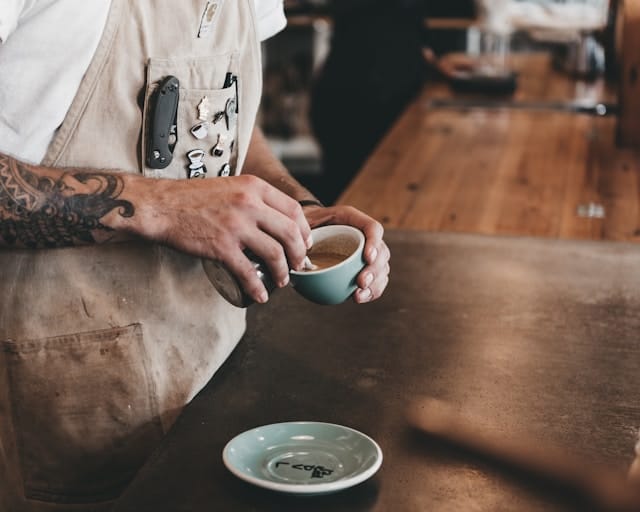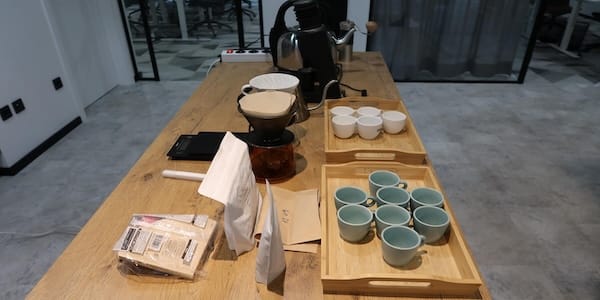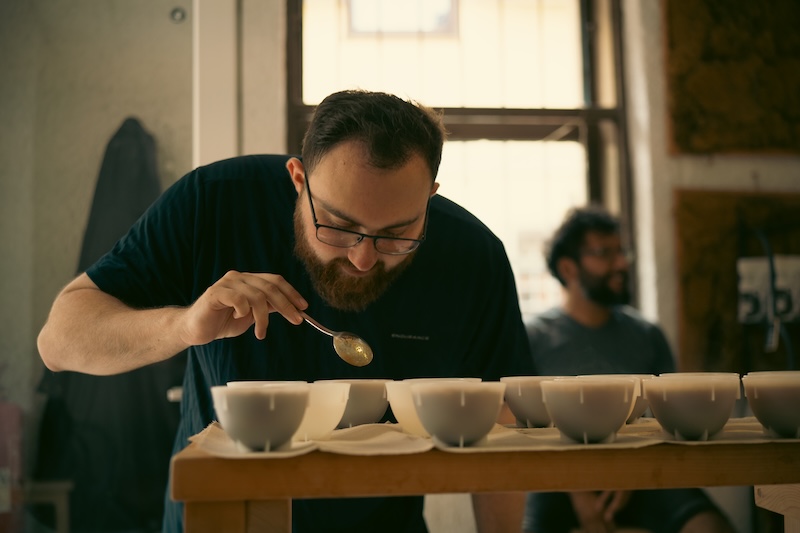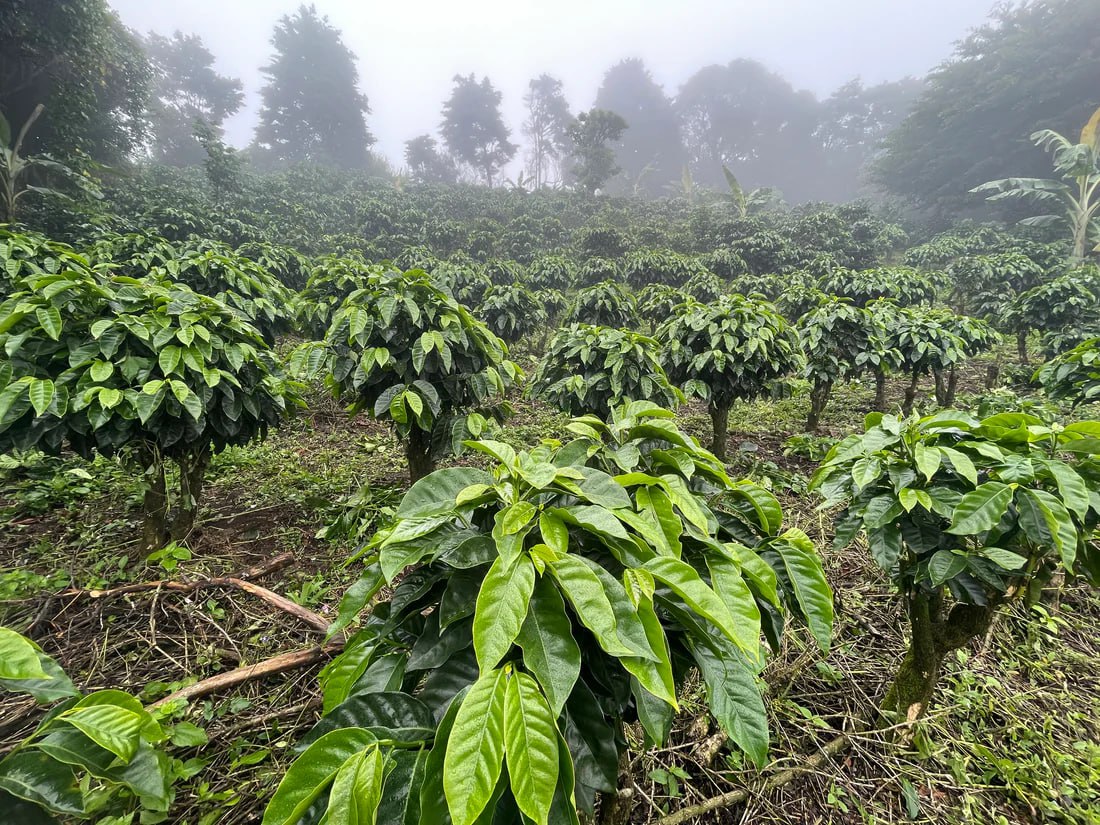ALL POSTS
ALL POSTS
Report: State of Specialty Espresso Quality in Ljubljana and Maribor, May-June 2025
8 min read
Last edit: Oct 10, 2025
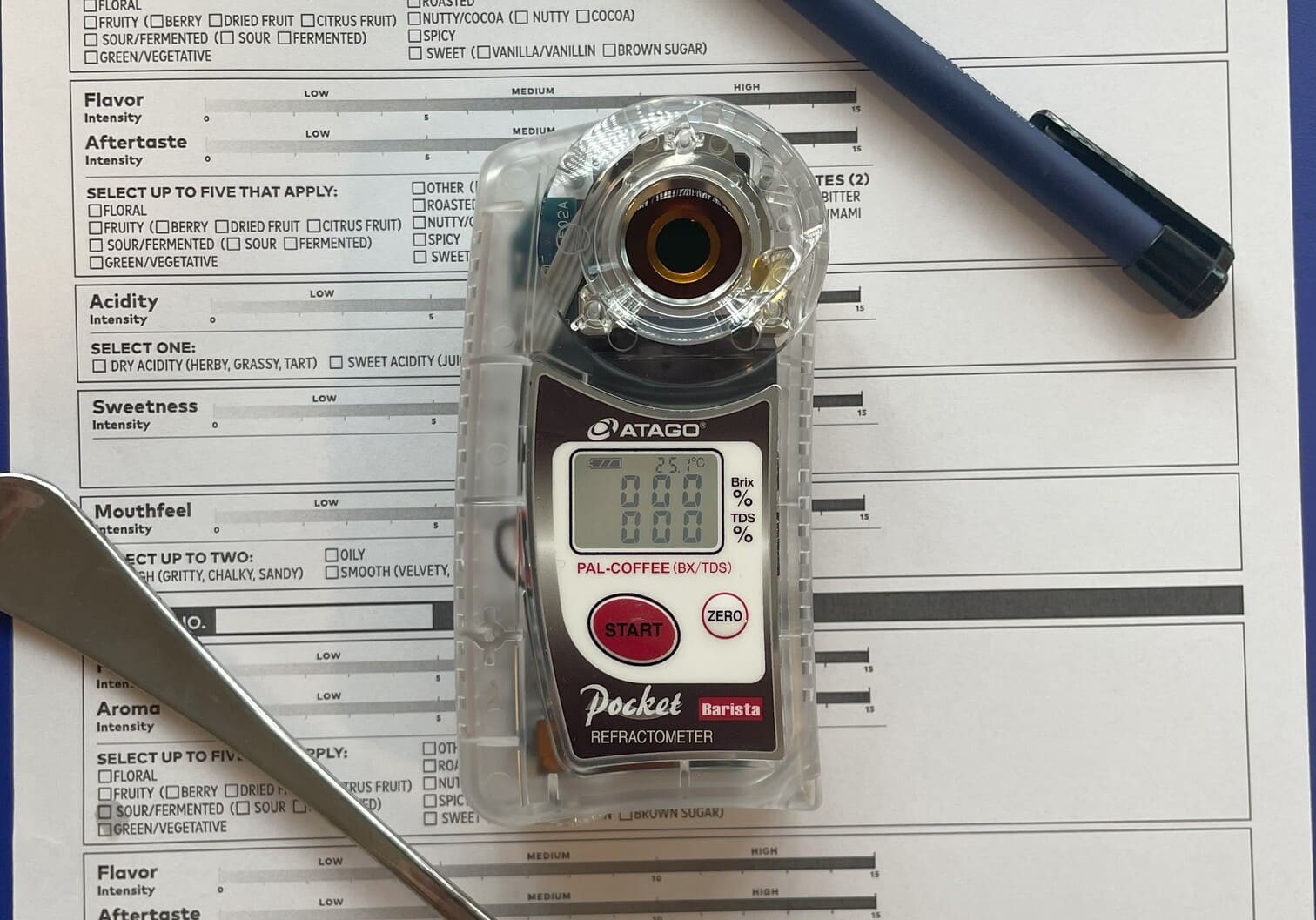
- Understanding Refractometry in Coffee
- Method and tools
- Espresso Quality Analysis Report
- Ljubljana
- 1. Mala Pražarna (Costa Rica Mirazu Black Honey)
- 2. Stow (Colombia La Cabaña Natural Anaerobic)
- 3. Črno Zrno (Colombia Villa Esperanza Natural)
- 4. Stow2GO (Honduras Las Calaveras Red Honey)
- 5. R&B Coffee Roasters (Rwanda Mukamana Sisters Natural)
- 6. Specialka by Goat Story (Brazil Caparao Coletivo Natural)
- 9. Moderna (Costa Rica Linda Vista Honey)
- 10. Lana’s Corner (Coronini n1 Blend)
- 11. Tri Marije (Colombia El Paraiso Carbonic Maceration)
- 12. Kavarna Cukrarna (Racer Blend)
- 13. 1C Specialty Coffee (C1000 Blend)
- Maribor
- Ljubljana
- Averages and Map
- Top 10 Extractions
- Implications and Operational Impact
- Conclusion
Espresso quality is a crucial benchmark for specialty coffee shops, not only influencing taste but also revealing how well a café manages its equipment, workflow, and understanding of coffee extraction.
Between 24 May and 6th of June 2025, refractometer data was collected from several specialty cafés in Ljubljana and Maribor.
The parameters analyzed included Total Dissolved Solids (TDS%) and Extraction Yield (Extr%), two of the most important objective and quantitative indicators of espresso quality.
In this report, we share the results and insights revealing the state of specialty espresso in Ljubljana and Maribor.
Data collection and report are a joint project of Združenje Specialty Kave Slovenija (ZSKS), specialtykava.si, and kavast_app.
Understanding Refractometry in Coffee
A refractometer measures how light bends as it passes through a liquid.
In coffee, it is used to determine the concentration of dissolved solids, namely the soluble compounds that make up the espresso’s flavor.
TDS% tells us how strong the coffee (espresso) is, while extraction yield (Extr%) is calculated using the input weight (dry coffee), output (brew weight), and TDS%, and represents the percentage of coffee material actually extracted into the final cup from ground coffee beans.
Using TDS% and extraction yield is an industry-proven objective way of controlling the quality of brewed coffee.
According to industry standards, an optimal espresso falls within TDS of 8–12% and extraction yield of 18–22%. Deviation from these ranges suggests under- or over-extraction, affecting both flavor and consistency.
Method and tools
To conduct the readings all espresso shots were filtered through a standard Hario V60 paper filter in order to remove emulsion (crema) and any coffee bean particles that may have gotten into the cup. Both emulsion and coffee bean particles may interfere with refractometer readings and therefore must be filtered out.
When the liquid got to room temperature the TDS% was measured using an Atago-pal refractometer that was cleaned and calibrated with water used in the cafe. To ensure repeatability of the data readings would be taken multiple times with the same coffee liquid after cleansing and recalibration with water.
Knowing EBF% (Espresso Brew Ratio i.e. espresso dose in and out relation), TDS%, and Extraction yield (Extr%) it is possible to make conclusions regarding the quality of the extraction.
Extraction yield (Extr%) is calculated by multiplying TDS by the dose of the liquid (out) and dividing the result (X) by the dose of ground coffee (in).
TDS * out = x
X : in = Extr%
For espresso, the table below is traditionally used. By cross-referencing all three figures we get a coordinate showing whether the espresso in question is well extracted or shows signs of over- or under-extraction.
All coffees were ordered and paid on sight by the Author.
Baristas were notified that the ordered coffee would be used for data gathering to be used in this material.
All notes regarding flavor profiles are the results of sensory analysis done by the Author.
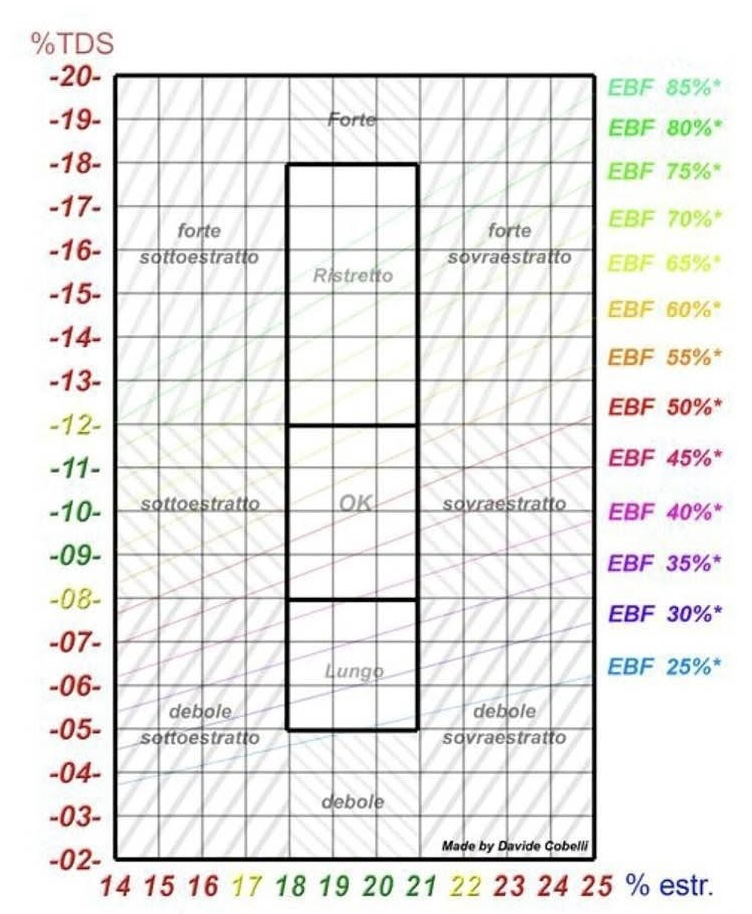
Espresso Quality Analysis Report
Ljubljana
1. Mala Pražarna (Costa Rica Mirazu Black Honey)
- TDS: 7.36% | Extraction: 19.56% | EBF 37.3%
- While the extraction yield is within the optimal range, the TDS is low, indicating a weak or diluted espresso, possibly caused by a very fast shot (15 sec).
- The taste test revealed a watery body, balanced sweetness, and acidity with flavors of ripe tropical fruits and raw almond.
2. Stow (Colombia La Cabaña Natural Anaerobic)
- TDS: 8% | Extraction: 19.56% | EBF 40.9%
- Up to industry standards extraction, suggesting a balance of flavors.
- Further tasting confirmed the readings with bright notes of pineapple, nutmeg, cocoa, and cherry.
3. Črno Zrno (Colombia Villa Esperanza Natural)
- TDS: 7.20% | Extraction: 17.06% | EBF 42,5%
- Both TDS and extraction are below the industry set optimal. The very short extraction time (12 sec) implies under-extraction, which can lead to sour, underdeveloped flavor profiles with grassy and veggie notes dominating.
- Tasting the shot outlined the unbalanced and astringent flavor profile with dominating notes of raw almond and cocoa.
4. Stow2GO (Honduras Las Calaveras Red Honey)
- TDS: 9.15% | Extraction: 19.06% | EBF 48%
- Well-extracted espresso, suggesting a balanced flavor profile.
- Tasting showed that the cup has strong notes of milk chocolate and dried fruits.
5. R&B Coffee Roasters (Rwanda Mukamana Sisters Natural)
- TDS: 8.84% | Extraction: 19.59% | EBF 45.2%
- Another textbook example of good espresso extraction.
- Tasting of the brew reflected data with a balanced, nutty, and chocolaty profile, and typical for Rwanda floral notes.
6. Specialka by Goat Story (Brazil Caparao Coletivo Natural)
- TDS: 5.45% | Extraction: 15.45% | EBF 38%
- Both numbers are significantly low compared to the norm. The espresso is likely extremely weak and underdeveloped.
- A taste test showed an overall harsh and bitter profile with a dominating hazelnut husk aroma.
7. Pražarna (Brazil Fazenda Semente Natural Anaerobic)
- TDS: 7.49% | Extraction: 21.15% | EBF 35.4%
- Well extracted by yield and under the optimal TDS. This may indicate too much brew water or too fine a grind, which can produce bitter or hollow flavor.
- Further tasting confirmed the conclusion above with a weak body and strong enzymatic bitterness on aftertaste.
8. TOZD (Colombia Rio Magdalena Washed)
- TDS: 6.95% | Extraction: 18.95% | EBF 36%
- Optimal extraction yield with low TDS and espresso brew ratio indicates a suboptimal extraction which makes the shot less flavorful and and more bitter.
- The taste test revealed a lack of complexity in the cup with an overpowering astringency and notes of raw almonds and grass.
9. Moderna (Costa Rica Linda Vista Honey)
- TDS: 10.40% | Extraction: 21.34% | EBF 48%
- Precisely extracted shot with all figures up to modern industry standards.
- Tasting this shot confirmed near-perfect extraction by delivering sweet and well-balanced flavors of honey, lemon, and kiwi with a bitter-sweet aftertaste.
10. Lana’s Corner (Coronini n1 Blend)
- TDS: 5.9% | Extraction: 21.45% | EBF 27.5%
- A low TDS, high extraction yield with low EBF point towards a channeling or an over-extended dose out (60ml).
- Further tasting also revealed an astringent taste which points to possible channeling or uneven coffee ground distribution.
11. Tri Marije (Colombia El Paraiso Carbonic Maceration)
- TDS: 7.65% | Extraction: 17% | EBF 45%
- Both TDS and extraction yield below industry standard are pointing towards under-extracting that might have been caused by channeling or insufficient contact time (26 sec).
- Tasting the shot showed an unbalanced and astringent flavor profile with dominating notes of over-ripen fruits and hints of vinegar, and grass with bitter-sweet aftertaste.
12. Kavarna Cukrarna (Racer Blend)
- TDS 8.58% | Extraction: 19.05% | EBF45%
- A shot in accordance with industry standards.
- The shot tasted balanced and sweet and had structured flavors of milk chocolate, roasted nuts, and vanilla with a mildly bitter-sweet finish.
13. 1C Specialty Coffee (C1000 Blend)
- TDS: 8.14% | Extraction: 20.8% | EBF 39%
- Optimal TDS and within standard extraction yield indicate an optimal extraction.
- The shot had strong nutty, chocolaty, and hay flavors with a weak, almost water-like body.
Maribor
1. Pisarna (Blend)
- TDS: 6.31% | Extraction: 21% | EBF 30%
- Low TDS and high extraction yield indicate channeling and suggest an overinflated out dose.
- The shot proved to be both bitter and astringent with unbalanced flavours of dark chocolate, soy sauce, and raw nuts.
2. Tovarna Kave (Costa Rica Don Alfonso Natural)
- TDS: 9.17% | Extraction: 21.17% | EBF 42.3%
- A by-the-book shot with a high extraction yield.
- The taste test revealed a bright but unbalanced flavour profile filled with fruity, mildly fermented notes of cherry, raspberry, red wine, and cognac that quickly gets overrun with a mildly bitter aftertaste.
3. PolEK (Ethiopia Mike Mamo Honey)
- TDS: 10.04% | Extraction: 20.08% | EBF 50%
- A perfect by-the-book shot.
- Beautifully balanced flavours of citrus fruits, white tea with hints of jasmine and sweet aftertaste.
4. Brewpub (Blend)
- TDS: 7.42% | Extraction: 20.05% | EBF 36%
- Shot brewed almost perfectly with low tds and optimal espresso brew ratio.
- The shot tastes full-bodied, balanced with flavors of roasted almond, milk chocolate, and brown sugar.
Averages and Map

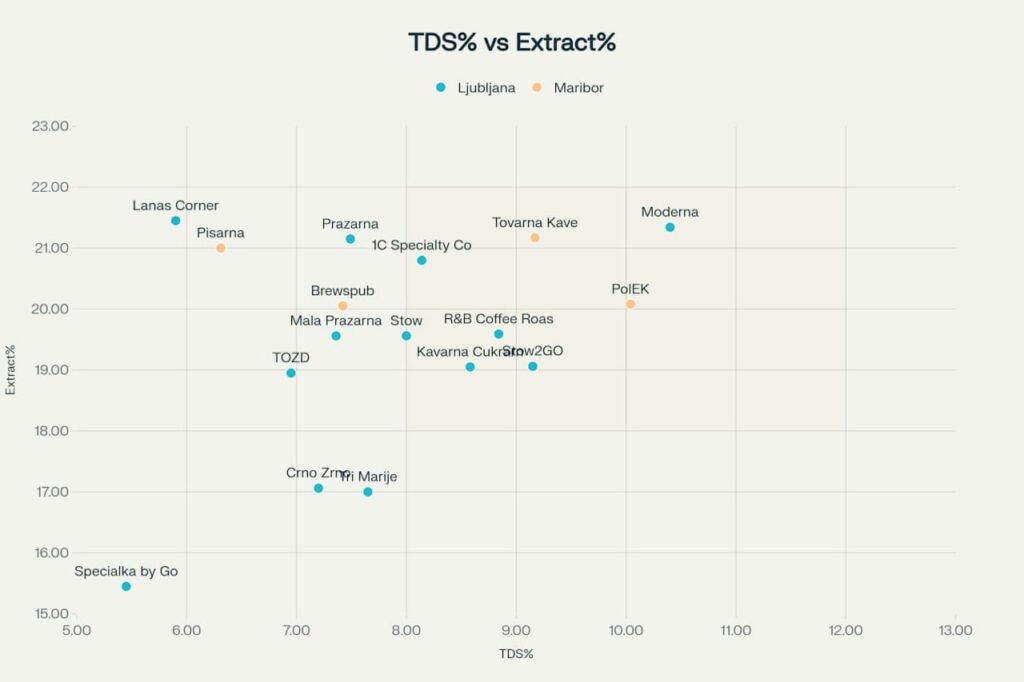
Top 10 Extractions
This rating compares the TDS and extraction yield reading of a shot to a “golden center” of industries standard, which is TDS 10%, Extr 20%, EBF 50%.
These numbers are used as a comparison point and are not an objective coordinate for the best espresso.
Optimal TDS for espresso: 8-12%
Optimal Extraction yield: 18-22%
This table does not compare levels of perceived sensory quality, quality of service, atmosphere, or other attributes of a café.
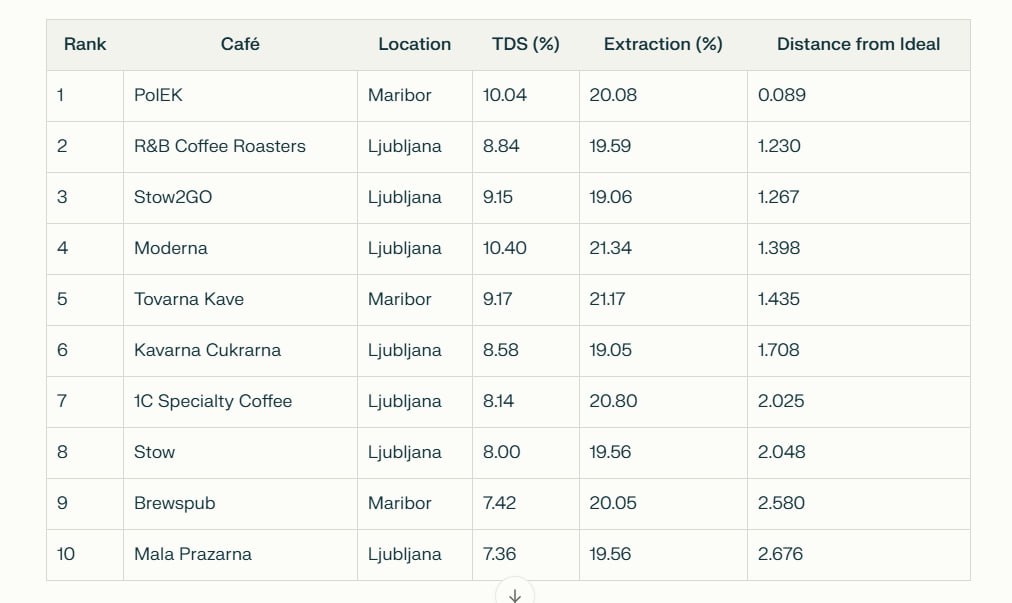
Implications and Operational Impact
Understanding and measuring espresso extraction allows cafés to move from subjective flavor assessments to data-driven consistency. Here’s why this matters:
- Flavor control: Under-extracted espressos are overly sour or water-like; over-extracted ones can be bitter and astringent. Accurate TDS and yield readings allow baristas to calibrate and troubleshoot.
- Training and consistency: Data exposes whether baristas are using equipment correctly or following standard recipes. This leads to better staff performance and fewer customer complaints.
- Coffee evaluation: Roasters and cafés use extraction data to evaluate how a particular roast behaves. This aids in roast profiling and communicating brew parameters to end users.
- Operational efficiency: Minimizing waste from poorly dialed shots saves time and cost. A 15–30 sec shot with ideal numbers is not just tastier, but also more efficient.
Conclusion
We thank all the establishments and baristas for their contributions, collaboration, and efforts in striving for the best quality of espresso.
Ljubljana and Maribor’s specialty coffee scene demonstrates a confident and growing maturity in espresso extraction practices and quality control, with several cafés like PolEk, Stow2GO, and R&B achieving textbook extractions while others like Mala Prazarna and Črno Zrno embrace the modern style of espresso extraction known as “turbo-shot”.
However, inconsistencies exist, particularly with cafés like Črno Zrno, Pisarna, and Specialka, where shot parameters indicate either under- or over-extraction.
Regular use of refractometry helps bridge the gap between subjective taste and measurable quality, enabling cafés to elevate their consistency, product quality, and ultimately customer satisfaction.
Specialtykava.si offers regular refractometry and sensory tests for cafes, as well as other consulting and support services.
Get the objective data to streamline your in-house quality control process and optimize espresso to industry standards.
Found this report useful and insightful?
Write to levvolodarsky@gmail.com to receive a quota for a refractometry and sensory analysis or suggest a topic for the next research.
Author: Lev Volodarsky, SCA AST and ZSKS chairman
Would you like to learn more about other coffee roasters in Slovenia? Here are the guides.



